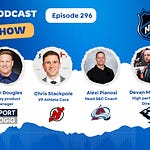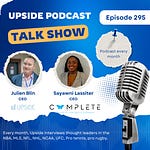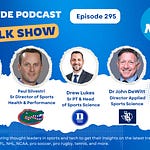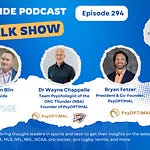This week we had the honor to interview Alexi Pianosi, the strengths and conditioning coach for the Pittsburgh Penguins, a leading NHL team.
📝 Show Notes: Through this conversation Great we touched on his background, his role at the Penguins, as well as the impact of COVID. We also discussed his top three favorite technologies. Lastly we touched on what he is looking for when buying new technologies and what makes Sidney Crosby his star player, so special.
🚀 Best Quotes: Here’s some of the key discussion points and best quotes from our conversation with Alexi:
On his background and how he got started in the world of elite sports: “So I'm actually from Halifax, Nova Scotia in the Eastern part of Canada, and I grew up playing hockey myself. I played for most of my life, and played through Major Junior in Canada. Then I moved on to play at Queens university collegiately. That's where I did my bachelors degree of kinesiology and at the time I was also running a private business and training hockey players and other athletes as a part-time job in the summer. I then graduated with my undergraduate degree from Queens. I decided to take my business to the next level and try to pursue that full-time”.
On how he ended up working for the Pittsburgh Penguins (NHL): “After I started operating my business year round. I worked as the strength and conditioning coach for the Halifax Moose heads, the major junior hockey team in Halifax. I was working for them for two years before a colleague and friend of mine, Andy O'Brien, who was at the time the director of sports science for the Pittsburgh Penguins, told me that the Penguins might have a job opening. And I applied in Pittsburgh and I was very fortunate to get that job after my first interview. I started in August of 2017. I'm just about to start my fifth year here in Pittsburgh and I've had the opportunity very fortunately to work with Andy O'Brien for about 10 years now in different capacities with the Penguins and in the private sector”.
On his role at the Pittsburgh Penguins: “ As the strength and conditioning coach for the Pittsburgh Penguins, I work with my colleague, Alex Trinca, who's also a strength and conditioning coach for the Penguins. We view strength and conditioning in the Pittsburgh organization as a very holistic approach. We are responsible for setting the schedule of workouts and setting up lifts, but we also oversee the recovery, injury prevention, and rehab process after injuries. Myself, Alex and another guy in our organization, Curtis Bell, handle the team's nutrition as well. So it has become a pretty holistic role in a lot of different areas of sports performance. And for myself and Alex, especially, anything that can relate to performance, whether it would be writing an individualized workout plan for a player to do on practice days or the morning of a game, doing some specific rehab exercises after an injury or in the later stages of the players’ return to play process. It could also be about trying to figure out how to customize a specific nutritional plan for an athlete to maximize energy availability. We take all of that on as our role of strength and conditioning coaches and basically anything we can do to help the performance of the players that’s what we are responsible for”.
On the impact of COVID-19 on his daily work: “There were two different phases of COVID. When our season got postponed in March of 2020, we went into lockdown mode, everything was closed, nobody had gym equipment, and nobody had home gyms yet because nobody was prepared for this. So there were almost three months of quarantine where we were just communicating with our players via texts and phone calls, trying to run sessions, trying to design workout programs and individualized plans that were specific to what the player had. Some people had a gym in their house, some people had not even a single dumbbell, or nothing but body weight. So trying to adapt to that was certainly difficult and we ended up spending a fair amount of time in meetings with colleagues and writing out programs and talking to athletes, and trying to keep things up and running. The thought was that it won't be that long. And we would be back at the rink soon, so we wanted to make sure we were ready. Ultimately, we ended up coming back in July for the NHLs return to play protocol as part of the NHL bubble that happened in Edmonton and Toronto. And that was the start of phase two, where we were back with our team but in a COVID world. And that was the same as last season where vaccinations were a relatively new thing so the vaccines were not available for very many people. Wearing a mask and gloves constantly was normal. Having very intense restrictions and not being allowed to leave your hotel on the road, was also the norm. So I think it was very challenging for everybody to have to deal with those protocols and not having too much freedom. I think the majority of people who went through this might tell you that it was just 10% or 15% more stressful every day just because of the nature of what COVID had to make you do”.
On the fact that COVID-19 made him appreciate the non COVID-19 world and the people he works with every day: “I think it made you appreciate the non-COVID world and the people you were working with so often. And having the opportunity to go through that with people and come out of it with your friends or colleagues and still with a good working environment, it was a real positive thing that we were able to take from the whole experience”.
On some of his favorite technologies out there and why, starting with Hyperice and Firstbeat: “I think of technologies in two different streams. There is the sport science data collection of players’ movements and load. And then there's the recovery performance side. On the recovery performance side, companies like Hyperice and Normatec have done a really good job making some really good products, but on the other side of the data collection when you look at what's happening on the ice, it's pretty exciting. Heart rate technologies are by no means a new idea. It's been around for a long time. You have a number of teams that work with Firstbeat out of Finland. And we found Firstbeat to be a really good system for us in terms of monitoring internal load and measuring the heart rate response to the particular practice that we have. I think it's always important to look at what you're getting from each piece of technology and the quality of the data we get from Firstbeat relative to the cost of getting it, I think it is pretty high. We get a pretty good sense of what's going on with the players on the ice, how hard it is for the players from a cardiovascular perspective, just by how they wear a heart rate monitor in the normal practice. So I think Firstbeat is a pretty important piece of technology for us”.
On his other favorite technology 1080 Quantum and Sprint: “We've actually just invested this year in a company called 1080MOTION which built the 1080 Sprint and 1080 Quantum. This company 1080MOTION has given us the two units. And we're just starting to explore some more specific pathways along the rehab process specifically. I think it's a very exciting time to start working with 1080MOTION and to be starting to use their Quantum and Sprint devices. I know they're a little bit more popular in the track & field world, and some of the field based sports like soccer, football, things like that, but there's only, to the best of my knowledge, two or three other teams that are using the 1080 Quantum in professional hockey. So for us to be able to use that in a hockey specific application and try to learn a little bit more about how it can help our players and our return to play protocols and things like that, is important. I think I would put 1080MOTION up there. Now I don't know too much about it just yet, but I'm really excited for what we're going to be able to learn from it. It can collect that data and what we're going to be able to do with data of that caliber and of that quality, is exciting”.
On the importance of measuring movements :”And then the last one is the idea of monitoring movements. Whether it's a GPS or inertial device like Catapult or an RFID technology like Kinexon. We personally use Kinexon at our practice facility. But with the NHL recently signing an agreement to collect in-game data using a company called SMT, we're going to start getting some data from in-games as well. So I think the opportunity is now going to be about learning a little bit more about what is actually happening on the ice in terms of speed and load, and what's happening in a practice. And it's a pretty difficult question because I think hockey is a very unique sport. Some sports start and end with a very similar path, whether it's a pitch in baseball, a swing in golf or the quarterback at the center for American Football. But hockey is so reactive. And even if you try to talk about the hockey skating stride, when you really stop and watch a game very closely and understand some of the nuances, there are 12 or 13 different types of strides that a hockey player can make. Whether it is a crossover stride, a forward, a backward stride, a pivot stride, a crossover into a forward acceleration, or a lateral motion. There are a lot of different ways players can move on the ice. And I think it's a really exciting time to start to try to ask some questions about how challenging and how demanding these different movements are on a player”.
On the kind of insights he hopes to get once they combine the data from Catapult, SMT and Kinexon: “I can tell you about one thing that we found really interesting using our Kinexon data. It was by looking at the movement data in terms of number of accelerations per practice or number of decelerations per practice and the differences in position (...). It is actually really interesting to look at some of the data at the end of a practice when everybody's going through the same drills, but the centermen are skating far further in terms of total distance and they have far fewer decelerations. They're just not stopping and starting as much by the nature of their position. And then even within that, if you look at different wingers or different centermen, the style of play that each athlete exhibits on the ice also lends itself to different levels of loading. So trying to ask some of these questions about how the centermen are different from a winger or different from a defenseman, and then how is this centerman different from that centerman and their styles of play and their approach to the game. So as we start to collect more data from systems like Catapult and Kinexon, and then incorporate more data from SMT as it becomes more prominent in the NHL, we're going to start to learn a little bit more about how demanding hockey is for the players. So I would put those movement capture systems like Kinexon, Catapult and SMT up very high on some of my favorite technologies. Because there are just so many questions you could ask. You'd have to look through a lot of data, but the data is there as long as you're asking the right questions and recording the right information”.
On load management and how technologies can help there: “ I think the idea of load management and understanding what players are going through and trying to optimize readiness and energy levels each time the puck drops or the ball tips off, whatever sports you're playing in it is always going to be important. People are always wondering “how do I get my players to be the most energetic, or the freshest when they need to be so that they can perform at their best?”. And the NHL has a very demanding schedule with 82 games. Usually we have a minimum of three, or sometimes five games per week. So it can be very challenging”.
On the importance of always asking yourself the right questions before adopting new technologies: “I think those questions are going to continue to be asked and technology, I think, has the potential to help answer some of those questions. Now there are so many technologies out there that do so many things that I think it's really important to make sure to ask the right questions. And I know when I sit down with our staff and our colleagues here we have so many questions, so then we have to figured out the best questions to ask and if we think this is the best question, then what do we need to measure? We can measure 20 different things, but which one is going to tell us the most useful information to help us answer that question? So it's really about using the technology as an assistant and not really letting the technology be the driver of the conversation. Understanding the sport and understanding that the demand will lead you to asking the right questions”.
On the importance of having future technologies that can be tailored to the specificities of each players: “We're talking about players who have very different anthropometric characteristics, very different nervous systems, very different genetic backgrounds and histories, very different injury histories, and that are at very different points in their lives. We have some 20 year olds on our team and we have some 37 year olds. So each player is unique in the way they play the game, and how they accomplish what they do and then there are their physiological characteristics. So I think the future of technology is also going to be about allowing us to assess the individual and tailor things to the individual while not distracting us from the team concept and the team environment too much. You'll never be able to run 20 different practices for guys in the NHL because teams practices together. But figuring out ways before or after practice to individualize and optimize whether it's performance training or recovery or soft tissue treatments or sleep metrics or devices to help improve sleep or recovery, is critical. Different things are going to work for different players. And at the same time, as you try to find those answers, I think you will also learn that what's going to work for this athlete is not necessarily going to work for the other athlete”.
On the three things that he is looking for when considering buying new technologies: “ You want to first know if the product is going to measure reliably what we want it to measure. And assuming that that's the case, and hopefully most products get past that part in the research and development phase. But then like you said, you have to determine logistically, does it make sense in your environment? (..) And if the players are building a negative relationship or negative connotation to that technology, then you're probably not going to get great results. So I think making sure it fits into your workflow, is very important. Then it has to provide something that you can connect back to a player's performance (..)And the connection always comes back to these players. They're typically very high performing and very competitive people. They want to do better, they want to help themselves win, and they want to help themselves be the best. So if you can connect the benefits of the technology to this, it will improve your performance or it will really affect your speed on the ice. Things like that. They're going to be very interested in that. And then it's on you and the technology to follow through and make sure that, Hey, using this information, we were able to help you with this and that as a result, you performed better, you played better, and you scored 15 goals instead of 10 goals”.
On Sidney Crosby, considered by many as one of the greatest NHL players of all time and what makes him a special player: “It's a very loaded question, because I think there are so many things that make him great. Having known Sidney for a long time, I think his work ethic and his desire to be the best is just something fun to watch every day. He comes to the rink every day, every workout, every practice, every game, and every chance he has to try to improve and be better, he's going to do that. And like we talked about, it's pretty tough to play an 82 game season, and when traveling, sometimes you play on back to back nights and it's very easy for guys to take a night off and we're very fortunate that he set the standard for our organization for a very long time. And he has never taken a day off. So I think that's something that I feel very fortunate to have been able to watch firsthand over the last several years. And I've been fortunate to know him as we're both from Nova Scotia on the east coast of Canada there. So I knew him a little bit before I worked with the Penguins, and getting a chance to see him and work with him, it's truly been a pleasure for me to watch that unfold in front of my eyes and now be a part of it in Pittsburgh”.
🔥Upside Chat: Pierre Barrieu, High Performance Director, Toronto FC (MLS)
🔥Upside Chat: Len Zaichkowsky, World-Class’ Sports Biofeedback Expert
🔥 Upside Chat: Machar Reid, Innovation Lead (Tennis Australia)











